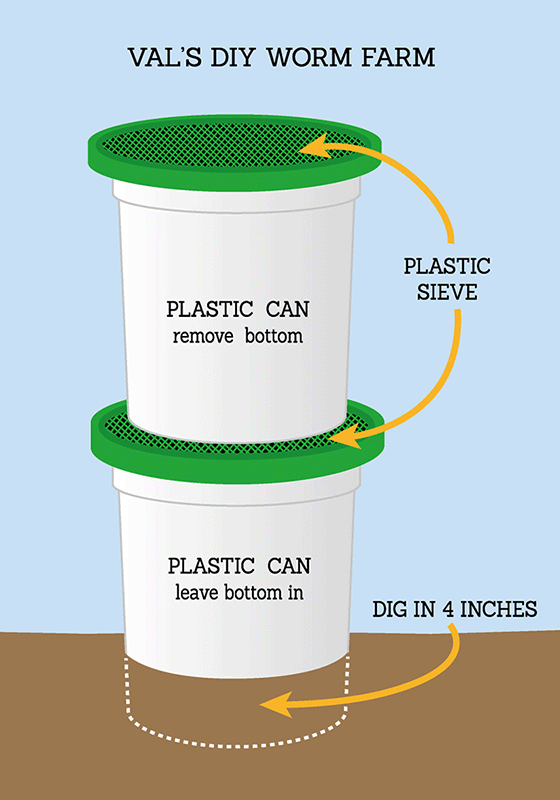A Surprise Romantic Wild Cottage Garden
The only one in an ordinary suburban street
of tidily landscaped front gardens
Let's be different!
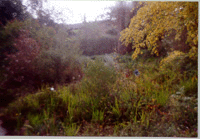 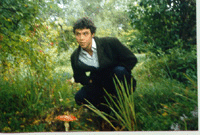 
making a small space look like a Miniature Botanic Gardens
The Book as a pdf
Index of the book - A Surprise Romantic Wild Cottage Garden
minimum care and drought resistant
-
MY WILD ROMANTIC COTTAGE GARDEN. A series on Bonzer e-magazine. www.bonzer.org.au
ENTERPRISE GARDENING
1 A surprise wild cottage garden .November 2003 Issue 27
http://pandora.nla.gov.au/pan/22764/20041123-0000/bonzerezine.bravepages.com/november-2003/gardening.html
2 Count yourgarden December 2003. Issue 28
3.MulticulturalDrought Gardens February 2004 Issue 29
4 Children's gardens Issue 30, March 2004
5 Garden wildlife – Strange Birds& ducks. Issue 31. April 2004
6 Make your own romantic miniature landscape garden. May 2004 Issue 32 l
7. Too wild life in the garden - animals rats pests Issue 33
8 An inexpensive roofwater for gardens Issue 34
9 No-Mo NatureStrip Issue 35
10. Count the flowers that bloom in the spring Issue 36
11. Saving the little Birds - preventing the extinction of small birds in our garden. Issue 38
12. Archaeology in the Garden Issue 39
13 The Problem of Unsustainable Gardens Issue 40
14 The No-Waste Garden of the Future Issue 41
15. Inventions. The Experimental Garden. Issue 42.
16. Flower sharing and depression – giving your garden to others. Issue 43.
17. Noise in a garden. Issue 44.
18. A hospital garden for children. Issue 45
19. Garden of the future. Issue 46.
|
About a surprise romantic wild cottage garden
The 200 plants in it
A roofwater diverter to save water
A simple Do-it-Yourself worm-farm for food scraps
and about the Mysterious Bird
______________________________
My Surprise Wild Cottage Garden has many
purposes -
• So passers-by are always surprised and delighted
by what flowers next.
• So I can give people and op-shops cut flowers, or at
least a bunch of parsley. Sometimes I give a flower to children on
the train.
If people already have the weed oxalis I can give away
plants, without spreading it further.
• For fruit and vegetables - although often these are
mini-vegetables
• For more pleasant, healthy and creative exercise than a
gym
• For outdoors exercise, which you dont get in a gym
• To encourage wild-life
• To be a garden that uses minimum water, costs as little
as possible, and requires as little mowing as possible
• A garden that can get by with as little or as much work
as I have time.
• To give me pleasure to look out on and be out in.
• To develop character in facing adversity and frustration
(that is, oxalis, onion-weed and some horrible grass-weeds).
• To be such a garden that when this house must eventually
be sold, people will rise up and say This must not be turned into
shoddy developer's units. We must keep this eccentric and livable
house for people to live in; for people who will also want to keep
this wild cottage garden for everybody to enjoy and children to
play in.
INDEX of the 35-page book
SOME DISTINCTIVE FEATURES AND PRINCIPLES OF THE SURPRISE WILD
COTTAGE GARDEN
• If the garden is full of plants there is less room
for weeds.
• Plants are given their chance, and from the ones that
flourish I take cuttings and self-sown seeds to plant elsewhere in
the garden, so it is basically a garden of 'What will grow
here'.
• I have a lovely theory that plants flourish from being
looked at. They dont even need to be sung to or talked at. You
just sit in the garden and watch them growing. Nobody is allowed
to refute this beautiful theory.
• When we first came here, parts of the garden had never
ever been dug - the bushland still here in the 1960s was just bare
or weedy earth. When we first dug these pristine areas of the
hill-top site, the topsoil was mostly 1 centimeter deep, with clay
below. (What a contrast Australian soil can be to our ancestral
earth in Aberdeen, Scotland, where our garden was over 2000 years
old, no fertiliser was ever needed, a stick grew if placed in the
ground, and digging even five feet deep was still rich topsoil. No
wonder farmers from Europe have been innocently wrecking this
country.) We have composted and mulched, and now we can dig at
least a spades-depth before reaching clay or grey powder.
• The nature strip is planted with 'anything left over',
and left to grow without watering or mowing. What survives, does.
Cars can park on the gutter side, no matter, plants will grow
again, and there is room for the bins to go out. What survives
beside the two trees is agapanthus, 3 sorts of gazanias, five
sorts of daisies (white, purple and yellow), Australian 'iris',
jasmine, honeysuckle, periwinkle, freesias, watsonias, two sorts
of iris, ixias, gladiolus, snowdrops, 'red ground-cover', a
flowering succulent, vinca, geranium, forget-me-not, a sh! baby
oak-tree, occasionally Australian century - and well, yes, some
weeds.
• The front lawn is being receded into a small place to
park and clean a car, but in which two sorts of daisies and many
clumps of freesias also grow. (And dandelions and grass-weeds.)
The garden is for 'survivors' - what will grow with minimum
watering. The frontage is mainly Australian shrubs plus bulbs and
daisy undercover. Camellias, azaleas, prunus, exotics, climbers
and a lemon tree grow against the fence and house, and other trees
are a silver birch, ancient gum-tree and mini-dogwood. Low growing
hardy plants are spreading up the grassy section of the drive.
Sometimes 'fairy toadstools, red and white, grow under the birch,
and there are many other fungi too.
• Pot-plants. I always have cuttings and often seedlings
growing - often self-sowns that I want to find out what they are.
Some tomatoes in old drums where they get maximum sun, and
flowering plants in tubs by the font and back doors.
• The back garden is designed to be the view as you come
down the passage, and to take in the trees behind the fence as
part of the view, Japanese style. It full of about everything that
will grow here (see list) - the once- lawn is now reduced to mere
tracks and a dumping ground.
There are three compost-heaps, one growing potatoes, one to
take from and one for dumping. There are four black compost bins,
one for worms and kitchen waste, two for general garden waste and
one against a sunny wall will hopefully cook the green weeds in
it.
I am reminded of the story in the New Statesman once of the
couple who got so keen on composting that the whole back yard was
eventually taken over, tramps disappeared, and eventually the
couple disappeared too.
• Self-sown. I always check unknown spontaneous seedlings,
because they have shown they can survive in our garden. - Hence a
passion-fruit that was laden for four years until
drought-stricken; tomatoes, potatoes, pumpkins, self-sown seeds
from our flowers, the baby oak-tree, prunus, little black-hoods,
arum lilies - and I am afraid, weeds.
• Organic gardening. I have a bag each of lime, gypsum,
blood-and-bone, potting-mix, a 'complete fertiliser' and a few
other bits and pieces, and they last ten years, added to the
compost as needed.
I tried RoundUp for the oxalis, and it flourished more, so use
no weedkiller, only exercise. For aphids I use soapy water and my
finger-and-thumb. For a white cottony scale on the dogwood I used
a kitchen detergent. For snails and slugs I occasionally use a
night-patrol, and sometimes a snailbait round seedlings, protected
from the birds. Occasionally a spray is needed for black spot on
the roses. Occasionally I have to put down ratkiller when rats are
eating my green tomatoes, and broccoli PLANTS down to the stalk,
and the tips of the lemon-tree that grew from a pip.
• The wild-life. See list. However, I worry about two
things.
i. The lack of insects - presumably through all my neighbors
zappers. There still seem to be mosquitoes, flies and blowflies,
but there seems nothing flying around to help my winter
broad-beans or my early spring cherry-plum to set.
ii. Protection of Australian predator birds seems excessive
when small birds now have humans and their related killers - dogs,
cats and cars - to take their place in the food-chain and
ecology.
Over the years small birds have disappeared from my garden, and
the birds are now only crows, magpies, pigeons, wattle-birds,
mynahs, kookaburras and lorikeets.
• Water economy. I have three of my own
Roof-water-diverters going from the down-pipes to where I want
water. I start mulching in October, using mulch from gumtrees that
had to be chopped when they became dangerous. I also use buckets
from bathroom and laundry in summer - but wish that house-design
now re-used clean grey-water, so that it could be diverted to the
lavatory or for garden use as suitable.) I train the plants to use
ground-water rather than surface-water and be generally tough by
giving minimum water in summer, soaking a small area at a time if
it needs it badly. What survives does, and it is amazing what does
survive this spartan training.
There is great pressure from developers to get rid of gardens and
back-yards, on very excuse possible - including their waste of water.
We must resist this.
My city of Melbourne used to be called a Garden City. This is
being threatened on all sides - public parks plantings at
shopping-centres and even in the city centre turned to monocultures
of job-lots to look like Arizona deserts, trees on nature strips
mutilated top and bottom for cables and clear vision for cars.
Everywhere children kept indoors.
Even nursing homes are becoming multistorey so the old folk cannot
even see a garden outside, let alone go out in one.What of the fresh
air from gardens, and the loveliness, and the good health!
Why one house and garden on a small block
is more fun than two Units
In my Wild Cottage Garden there are over 200 different sorts of
plants - many with names I do not know - plus eight regular bird
species and 37 other sorts of creatures!
|
annuals self-sown
California poppy,
forget-me-not
love-in-a-mist
tall bright-pink
|
daisies
purple Michaelmas
lawn daisy
navy-centred
yellow-centred
that little rockplant that goes everywhere
marigolds
yellow daisies, yellow centres
|
fruit
lemon
passionfruit
rhubarb
loganberries
|
herbs
mint - two sorts
parsley - two sorts
oregano
thyme
chives
rosemary
wild garlic
|
groundcover
redleafpink flower
gazanias - three sorts
silver-leaf white flower
|
|
shrubs and bushes
camellias
cretagus
veronica
many azaleas
several lavenders
several perennial stocks
several japonicas
lotta roses, climbing, once- standard, dwarf and from
cuttings,
cotoneaster
holly
oleanders
fuchsias
japonica, red, white,& pink,
flowering dontknows,
|
natives
'Australian iris'?
banksia red
banksia margenatus,
blackhood ?lily
callistemon citrinus endeavour,
correa
dwarf banksia bricifolia,
eriostemon myorporaides,
flowering eucalyptus grossa
grevillea rosemarinifolia
grevillea audicuali
hakea salicofolia,
kangaroo paw
large shrub with tiny mauve flowers
leptospermon,
native-rosemary,
straggly-cootamundra-wattle
ti-tree
tinyhardlygrow.
two treeferns
waxflower
tiny-pink-groundcover
wild-flower - Australian century
|
bulbs
'black lily'
'bluebells'
'pink lily
autumn crocus
daffodils
freesias
grape hyacinth
ixias
jonquils
lily-of-the-valley -some-day- it-- may -flower,
narcissi
pale blue 'bluebell',
snowdrops
tulips
|
creepers
briar rose
climbing eucalypt
climbing geranium
dogwood
flowering ?cherry,
fragrant clematis
grape vine (birds get there first)
happy wanderer
honeysuckle
jasmine
lemon,
oak! self-sown
old-man's beard
pittosporum recurring,
plumbago
potato creeper
tecoma
three ivies
trumpet-flower
two passionfruit
two wattles
vinca
virginia creeper
white clematis(?)
|
Trees
prunuses
red deciduous
remains of three gum trees,
several dont knows,
silver birch
|
|
EXOTICS
agapanthus
chrysanthemum
sweet william
christmas roses
periwinkle
several sorts of geraniums,
nasturtium
polyanthus
impatiens
honesty
large-leaf salvia
? 2 everlasting salvias,
carnation
Japanese anemone,
antirrhinum
sweet alice
convolvulus mauretania,
succulent
flowering cactus,
cerise flowers,
spiky flowers,
'snails' home',
|
FUNGI
largish red,
tiny red,
brown dinner-dishes,
frilly on wood
red on wood
tiny weeny caps,
occasional fly agoric (dramatic red-
with-white-spots)
|
VEGETABLES
silver beet
tomatoes
dwarf beans
broad beans
sweet corn
potatoes
miniature leeks
minibroccoli
CORMS AND TUBERS
'never flowered yet'
arum lilies
dark-blue iris
dutch iris
flag iris
gladioli
Japanese water iris
large yellow dahlias
red dahlias
watsonia
white-stripey-leaf
|
LAWN
several grasses many weeds
clover
dandelions
dwarf daisy
tiny daisy
WEEDS
? paspulum
buttercup
chickweed,
couch grass- several versions
dandelions
deeprootroundleaf,
dock
non-oregano
onionweed
oxalis
recurring blackberry,
several horrid grasses
sorrell
sticky billy
thistle, flat
thistle, milk
thistle, prickly
|
not sure of category
tough fern
little-blue-flowers
little white flowers on spikes
little mauve flowers on spikes
shrub with little bright blue flowers
about 8 other unknown shrubs and flowers unknowns
self-sown
several trees and plants
|
Wildlife Magpies, crows,
kookaburras, lorrikeets, noisy minahs, wattlebirds, blackbirds, and
in the 2001 summer, banded rails, rats, mice, ? voles, possums, ants, bull-ants, worms, cutworms,
nematodes, skinks, centipedes, millipedes, flies, mosquitoes,
blowflies, dragonflies, butterflies, moths, bees, wasps, beetles,
mantises, ladybirds,at least six sorts of spiders, leaf spiders,
huntsmen, silverfish, aphis (treated with squashing and soapy water)
,mites, midges, earwigs, snails, slugs, cabbage-moth, caterpillars
various, occasional dogs and children and adults
Diseases blackspot, rust,
mould, wilt, scale, cotton-scale (treated with jiff household spray),
potato scab
Plus 3 compost heaps, 4
compost bins, 2 pergolas, 3 garden sheds, 2 garden chairs, one garden
table, one old-style Hills Hoist, bitsa paths and lotsa junk
An inexpensive Roof Water diverter for
Gardens
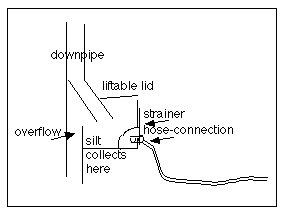
As our erratic climate becomes more erratic and as our
population grows, saving water becomes essential. Water tanks are
now allowed for suburban gardens, but they take up space and can
be expensive.
The diagram shows a roofwater diverter installed at our home
for watering the garden.
The diverter allows rainwater from the roof to be diverted to
any dry part of the garden at any time, by an ordinary garden hose
or cheap agricultural plastic hose, If the garden is watered
sufficiently or if there is overflow, the water can go straight
down the downpipe. The water goes down the hose by gravity. The
hose can be removed and outlet blocked at any time.
A strainer (e.g.from a mesh tea-strainer) fixed over the outlet
can prevent blockages, or, if necessary, leaves, silt etc. which
collect at the bottom of the box can be removed easily.
Cost apart from existing downpipe box: Hose connection $7
Agricultural hose $7
Altering downpipe box - price of plumber or handiman
Variations
The diverter box could be placed high enough on the
downpipe for a tank to be filled, or to allow higher parts of the
garden to be watered by gravity.
This sort of simple gadget could be produced and sold cheaply,
so that people can install it simply by putting a section in a
downpipe from the roof. If anyone makes a profit from it - give us
a royalty which we will use for further conservation
developments.
A note on this invention was published in Alternative
Technologies .
A simple worm-farm
that vermin cannot enter, and that can save you wasting plastic bags as bin liners for your kitchen rubbish. For all food scraps except bones, citrus and tealeaves.
| |
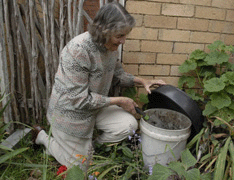 |
This simple design for a home-made worm farm is rat-proof, and fits a small shady space. All you need is an empty plaster-can and two cheap plastic garden sieves.
Builders and plasterers at a building site will give you a can rather than throw it in a rubbish skip.
Place one sieve in a flat space in damp ground, about 5-10 cm deep.
Cut the bottom from the can. Place the can on the sieve.
Top it with the second sieve. (If there are very clever rats around, weight this sieve with half-a-brick, so vermin cannot lift it off.)
The sieves stop rats, mice and blowflies getting in, but allow worms perfect freedom to come and go from the earth. A few fruit-flies do not matter. Start off the worm-farm with some damp earth with a few worms in it. They will multiply quickly, so no need to buy worms.
Then all you do is add your kitchen scraps – but no bones. Worms don’t like citrus, egg-shells or tea-leaves much, so put those in the compost. After a few weeks, for some rich fertiliser from the garden, just lift the can and take some from the bottom, full of worms. Shift the farm around the garden if you like.
|
|
| |
|
Advantages. Only bones need go in the rubbish-bin. No food-scraps in the compost-bin or compost heap to attract rats. No waste of empty plaster-cans. No smell.
Suggestions. Neighbours in flats can share a worm-farm.
Builders need not waste empty plaster-cans, but put them outside a site to be taken. Paint and plaster cans are useful for gardening buckets too, and for making liquid manure.
Councils could advertise or sell these very cheap worm-farm kits, as well as the more expensive commercial worm-farms that many do sell. Then everyone could afford one.
|
|
The story of our
Mysterious Birds
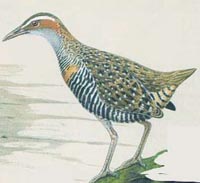
1. January 2001 A Mysterious Bird was stepping daintily
around the ruins of our jungly and unwatered back-yard, seeming
unaware that I was watching him.
About the size of a wattle-bird, but dainty, with thin beak and
thin
legs a bit longer than a wattlebird, and made very distinctive
by bright orange around its eyes and round the back of its neck,
with black and white also around its eyes, and variegated
brownish-greyish wings and banded throat and stomach. Its mate did
not appear to have the orange, white and black around its eyes and
was altogether more demure. It sat for an hour under some vinca
leaves - and I hoped it would not nest there because we have rats
from the school next door.
Two days later, the Mysterious Bird appeared again, strolling
around quietly with its ? mate, and it was possible to watch them
from quite close as they seemed quite self-possessed and
unjittery. But when I went to get a sketchbook and camera they had
gone.
Over the summer there were up to six Banded Rails appearing in
our back yard. They are well camouflaged, and you usually hear
them scuttling in the undergrowth before you see them.
The first to come were two adults, one with orange neckwear,
and than later four smaller ones (younger?) like little bantams
with striped stomachs and Cleopatra eye-makeup. They scuttle
around, and I could get to within one foot of them. This lack of
fear may make them vulnerable to cats and rats, especially as they
are basically ground birds and probably ground-nesting.
I think these swamp birds may have come because our back yard
is a bit like a deserted wilderness just now - very home-like for
them.
Later there were just three birds rustling around in the
garden, and then one that became quite tame, and the other two
occasionally appearing. I left out a little budgie seed for them
from time to time but not enough to make them dependent. I saw
them eating seeds from the grasses. The 'tame' one once ate out of
my hand.
I never heard them make a sound - only the rustling in the
undergrowth. When frightened, they did not fly, they ran, with
their heads bobbing forward and their tails going up and down like
bantams. when they flew, their legs trailed.
The tame one sometimes sat on the roof and came down when it
saw me. It liked having a bath in the small bird-bath - flapping
its wings. Or just standing in the water.
After George died, it was comforting to have the little bird
appearing in the garden every day. It also went next door, which
had a native garden.
In March came the first cold snap. I saw the little bird
parading outside our back window for about half an hour. Then I
never saw it again. I hope it had gone to warmer climes, and had
not been taken by any predator.
Description. A pretty, dainty bird, Smaller than a bantam but
behaving very like one - with long thin beak and legs, Cleopatra
eye-makeup, with white and brown around eyes, banded black and
white thorat and stomach with orange cummabund half-way down, and
browny-black-white- mottled back feathers like a brown duck.
From Bird Book. Simpson and Day, 182. S & D says that their
habitat is "grassy, reedy or thickly vegetated areas, usually
close to water."
Back to top
Back to Ozideas Home Page
|






